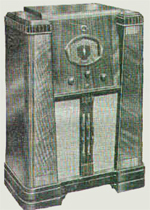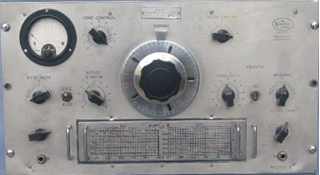HISTORY:
For the collector of all things "vintage audio"
Over the years curious products have appeared in the world of audio, from the very early "wire recordings" (previous to magnetic tape) through to these cardboard backed flexi-discs.
Terrible audio quality but intended as a novel way of sending another person a special message, in this case a little 3 year old's birthday.
Originally a square shape, the edges have been trimmed to represent a more "normal" circular record. Place on your OLD turntable and you will be greeted by a male singer, Chris Christensen accompanied by piano. Chris was active in the Sydney & Brisbane broadcasting industry during the 1940's and in the 1950's he moved to Melbourne.
Kingsley Radio Co. was not just a flexi-disc manufacturer in Melbourne, far from it. They designed and produced various radio equipment for both the domestic market (Model K50 for example)

and for military & aeronautical use in Australia by Civil Aviation and the R.A.A.F services, the famous AR7 ground station receivers being another example of their technological "prowess"

Notice that the Flexi-disc mentions that a patent had been applied for ... I have been unable to locate those patent records, it would make for interesting reading.
Back to the record ...
Note, this is the 1950's and the "standard" running speed of domestic record players was 78 rpm, much faster than today's 45 or 33rpm. Also tonearm/head technology was not really refined and the stylus (needle) used was much wider than modern types, often with a much higher stylus pressure = faster wear on the poor old record.
This means that unless your current turntable can run at 78, Chris (the singer) will sound very much like a bass-baritone singer! Unfortunately all my 16 & 78rpm gear has "left the building" so I had to transcribe the vocals by listening at 45rpm
The exciting lyrics are ...
Happy birthday to you
Happy birthday to you
Happy birthday to you
Happy birthday to you
I know someone very special and because you are that someone this message comes to say a very happy birthday
Happy birthday to you
A now lets all sing it together
Ready? Here we go
(Piano playing Happy Birthday)
Happy birthday to you
This is a flexi-disc which instead of being just all plastic (as with the later flexi-discs which often were used by companies for marketing or magazine give-aways) this flexi-disc has a cardboard backing.
It is vital to keep this record FLAT otherwise (if you were going to play it) you will have mistracking all over the place due to the uneven surface.
Keep in mind that these records were not designed to be long lasting (a bit like acetates) and after just a few plays, that is the end of their useable lifetime.
So let's get down to some specific details of this disc ...
VALENTINES SINGING GREETING CARD - A Happy Birthday To You
Manufactured & Produced by Kingsley Radio Co. Melbourne
Disc type: Cardboard backed Flexi-disc
Single sided!
6 inch diameter disc
Cardboard thickness: 0.3mm
Cat # 35189/58
Year of release is the 1950's - possibly 1958 based on the catalogue number coding but I really don't know for sure.
Correct running speed is 78 rpm
Content is vocals sung by Chris Christensen with piano accompaniment - lyrics are above
The reverse (non-playable) side has a printed greeting intended for a 3 year old.
The front (Red/Black coloured) face of the record has a Black rectangle which is blank. This appears to be an area for the giver of the record to write or stick a label with the receiver's name on it - personalising the record.
We have no cover, we never had one but the record has been kept in one of our special archival cardboard sleeves and then "sandwiched" between two sheets of stiff cardboard to keep the record flat. It will be supplied in the same manner.
The archival sleeves or covers are made using a heavy card with an internal plastic liner permanently afixed inside. Two reinforcing strips on the outside and no writing on the vanilla cardboard sleeve at all. We used lots of these for broadcast station libraries.
The flexi-disc surface looks to be in good condition, no obvious dents! I have played this record so that I could transcribe the lyrics and while I could understand the lyrics fine, the surface noise level is pretty high ... this is not your high fidelity type of media!
This is probably made worse because back in the 1950's, gramophones had a wider needle so the grooves on this record are probably quite wide which means my modern stylus would tend to "swim around" inside the grooves, creating this extra surface noise.
So, this little piece of 1950's cardboard/plastic is interesting in so many ways - the marketing of such a product in the 1950's would have been seen as very novel for the times, the technology involved and the company behind the product - all Australian dinky di innovations!









